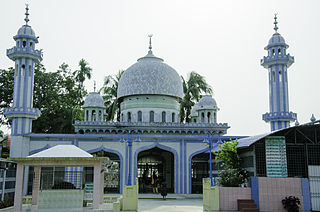
Shariatpur is a district in the Dhaka Division of central Bangladesh.
Burunga massacre was a massacre of at least 71 members of the Hindu population of Burunga and nearby villages on the Burunga High School grounds, in the district of Sylhet by the Pakistani army on 26 May 1971.
Galimpur massacre was a massacre of the Hindu population of Galimpur in the district of Sylhet by the Pakistani army on 20 May 1971.
Akhira massacre was a massacre of the emigrating Hindus of the then Dinajpur district near Baraihat on 17 April 1971 by the Pakistani army with collaboration from the local Razakars. It is estimated that around 100 Hindus were killed in the massacre.
Ramna massacre was the massacre of Bengali Hindus who lived in the region around the Ramna Kali Temple in East Pakistan by the Pakistani army on the night of 27 March, 1971. It is estimated that around 250 Hindus were killed in the massacre.
Makalkandi massacre was a massacre of over 40 Bengali Hindus of the Makalkandi village in the Habiganj Sub-division of undivided Sylhet district of East Pakistan by the Pakistani army on 18 August 1971.
Karai Kadipur massacre was the massacre of unarmed Hindu villagers of Joypurhat on 26 April 1971 by the Pakistani army and the Razakars. 370 Hindus were killed in the massacre in the villages of Karai, Kadipur and other adjoining villages.
Dakra massacre refers to the massacre of unarmed Hindu refugees at the village of Dakra, in the Bagerhat sub-division of Khulna District on 21 May 1971 by the Peace Committee members and the Razakars. The attackers were led by Rajab Ali Fakir, the chairman of the Bagerhat sub-divisional Peace Committee. More than 2,000 Hindu men, women and children were killed in the massacre.
Adityapur massacre refers to the massacre of 63 Bengali Hindus by the Pakistani army during the Bangladesh Liberation War at Adityapur in East Pakistan. On 14 June 1971, the Pakistani army in collaboration with the Razakars, killed 63 Bengali Hindus in the village of Adityapur in Sylhet district.
The Suryamani massacre of 24 Bengali Hindus took place on the early hours of 7 October 1971 in Suryamani village of the then Barisal district in East Pakistan. The Razakars shot dead 24 Bengali Hindus.
Krishnapur massacre took place on 18 September 1971 in Krishnapur and neighbouring villages in the district of Sylhet in Bangladesh. In Krishnapur, the Pakistani army shot 127 Bengali Hindus to death. In the neighbouring villages more than a 100 Hindus were killed.
Bakchar massacre refers to the massacre of nine unarmed Bengali Hindu residents by the Razakars on the instructions of Ali Ahsan Mohammad Mojaheed in the village of Bakchar in Faridpur district on 13 May 1971. On 17 July 2013 the International Crimes Tribunal found Mojaheed responsible for the killings and sentenced him for life. In 2015, a four-judge bench of the Appellate Division of the Supreme Court reduced the death sentence to life imprisonment.
Sendia massacre was a massacre of unarmed Bengali Hindus in Sendia village in undivided Faridpur district on 20 May 1971 by the Pakistan Army.< 127 Bengali Hindu men, women and children were killed in the massacre. The killers did not spare even the pregnant women, children or the elderly people. 76 out of the 127 victims were women.
Shankharikathi massacre refers to the killings of unarmed Hindu men by the Razakars in Shankharikathi market, Alukdia village of greater Khulna district in Bangladesh on 4 November 1971. 42 Hindus were killed in the massacre.
Bagbati massacre refers to the killings of more than 200 unarmed Bengali Hindus by the Al Badar, Pakistan Army, Razakars and Peace Committee, in the Bagbati Union of Sirajganj sub-division in the erstwhile district of greater Pabna in May 1971. After the massacre the bodies were buried or dumped in wells.
Kaliganj massacre refers to the massacre of over 400 unarmed Bengali Hindus in East Pakistan fleeing to India in Kaliganj market, in the present day Jaldhaka Upazila of Nilphamari District on 27 April 1971. An estimated 400 Bengali Hindus were killed by the occupying Pakistan Army. It is alleged that this massacre was masterminded by Muslim League leader and central minister Kazi Abdul Kader.
Ishangopalpur massacre refers to the massacre of Bengali Hindus in Ishangopalpur village, in the outskirts of Faridpur on 2 May 1971. The Pakistan army shot and bayoneted 28 Bengali Hindus to death.
Baria massacre was the massacre of unarmed Bengali Hindus in the village of Baria in present-day Gazipur Sadar Upazila of Bangladesh by the Pakistan army on 14 May 1971. Around 200 Bengali Hindus from Baria and nearby Kamaria were killed in the massacre, while hundreds more were injured.
Hasamdia massacre was the massacre of 33 unarmed Bengali Hindus in the Hasamdia village and nearby areas of the Faridpur District of East Pakistan on 16 May 1971 by the Pakistan Armed Forces. 33 persons were killed in the massacre. On 21 January 2013, the International Crimes Tribunal adjudged Abul Kalam Azad guilty of genocide for his involvement in the massacre and sentenced to death.
Nikli massacre was a premediated massacre of 35 Bengali Hindus in the Dampara Union of Nikli Upazila of Kishoreganj District, Dhaka Division, on 21 September 1971 by the Pakistan Army in collaboration with the Razakars during the Bangladesh Liberation War. According to sources, 35 Bengali Hindus were killed by the Pakistani Forces and the Razakars.

